Interesting facts about the history of the Chinese lunar program and the Chang'e-4 space mission

Much is hidden behind the fences of the landfills and the walls of the laboratories of the Chinese Academy of Space Technology in the implementation of lunar space research programs, but some of the information is then still kindly provided to the public.
In continuation of this publication.
Previously published materials about Chang-4:
1. The Chang'e-4 spacecraft successfully landed on the far side of the moon and sent the first photo.
2. An on-board video of the preparation and landing processes, as well as a panorama of the reverse side of the moon from Chang'e-4.
3. Video of the process of launching the Yutu-2 rover, its first meters on the moon's surface. A two-week dream on the moon is over
4. Pride and passion, the story of turning a dream into a space project
5. NASA's lunar orbiting probe took the first pictures of the Chinese Chang'e-4 station - two pixels of light
6. The Chang'e-4 module and the Yut rover -2 "ready for the second night on the far side of the Moon
7. NASA's lunar orbiting probe took new pictures of the Chinese Chang'e-4 station - closer and clearer
1. The Chang'e-4 spacecraft successfully landed on the far side of the moon and sent the first photo.
2. An on-board video of the preparation and landing processes, as well as a panorama of the reverse side of the moon from Chang'e-4.
3. Video of the process of launching the Yutu-2 rover, its first meters on the moon's surface. A two-week dream on the moon is over
4. Pride and passion, the story of turning a dream into a space project
5. NASA's lunar orbiting probe took the first pictures of the Chinese Chang'e-4 station - two pixels of light
6. The Chang'e-4 module and the Yut rover -2 "ready for the second night on the far side of the Moon
7. NASA's lunar orbiting probe took new pictures of the Chinese Chang'e-4 station - closer and clearer

A Brief Chinese History of Moon Exploration:
1991: Chinese space industry experts have proposed launching their own (including independent from other countries) moon exploration program.
1998: Chinese scientists begin planning the Lunar program, discuss the details of research and confirm the feasibility of the space mission on their own, overcome the first scientific and technical problems that arose at the initial stage.
January 2004: The Chinese Moon Exploration Program officially named “Chang'e” (in honor of the Chinese Moon Goddess) was officially launched. The first automatic satellite, which is planned to be launched into the orbit of the moon, is called Chang'e-1. The country's ambitious lunar project includes three phases: unmanned exploration of the moon, sending people to the moon and creating a base on the moon.
October 24, 2007: The Changzheng-3A booster rocket with the Chang'e-1 satellite was successfully launched from the Sichan space center in China.
November 7, 2007: Chang'e-1 satellite successfully entered the 127-minute lunar orbit at an altitude of 200 km.
October 2008: the start of the second phase of the Chang'e-2 program was officially approved by the State Council of the PRC.
November 12, 2008: China releases its first full lunar surface map based on data from Chang'e-1.
March 1, 2009: the pioneer of the Chinese lunar mission, the Chang'e-1 satellite, which performed its orbital flight for 16 months, completed its work by a controlled fall on the lunar surface.
October 1, 2010: The Changzheng-3S booster rocket with the Chang'e-2 satellite was successfully launched from the Sichan Chinese spaceport, then the Chang'e-2 satellite entered the 118-minute lunar orbit at an altitude of 100 km.
July 9, 2011: Chang'e-2 satellite left the lunar orbit to the Lagrange point L2 of the Sun-Earth system (1.5 million kilometers from Earth) for conducting scientific experiments.
August 25, 2011: After a 77-day journey, the Chang'e-2 satellite entered orbit around L2.
February 6, 2012: China released an updated more detailed lunar map, created according to data from the Chang'e-2 satellite.
July 14, 2013: Chang'e-2 satellite, having become an artificial asteroid in the Solar System, was 50 million kilometers away from Earth.
December 3, 2013: The Changzheng-3V booster rocket with the Chang'e-3 station was successfully launched from the Sichan space center in China.
December 14, 2013: Chang'e-3 lander makes landing in the Rainbow Bay crater on the visible side of the moon. The Chang'e-3 lander contains the first Chinese lunar rover, Yutu.
January 25, 2014: the Yut rover was technically immobilized (failure of elements as a result of a collision) after overcoming 114.8 meters on a complex lunar surface.
October 23, 2014: Chang'e-5T1 automatic lunar station was launched with the help of the Changzheng-3C launch vehicle from the Sichan Cosmodrome. The goal of the project is to test the return of the descent vehicle to Earth for further use of this technology in the Chang'e-5 mission.
October 31, 2014: the Chang'e-5T1 project descent vehicle detached from the service module, entered the Earth’s atmosphere and made a soft landing in the khoshun Syzzivan of Inner Mongolia Autonomous Region.
February 18, 2016: Chang'e-3 lander continues to operate normally after 28 lunar days, exceeding the estimated and design hardware lifetime.
December 14, 2016: the Chang'e-3 landing module worked on the lunar surface for three years, which is a record period for the lander to operate on the lunar surface.
May 21, 2018: The Tseyuqiao Satellite Relay (Forty Bridge) was launched from the Xichang Chinese Cosmodrome, it is necessary for organizing communication between the Earth and the far side of the Moon.
June 14, 2018: Tseyuqiao satellite relay entered orbit around the Lagrange point L2 of the Earth-Moon system, approximately 65,000 km from the Moon, becoming the first communication satellite in this orbit in the world.
December 8, 2018: The Changzheng-3B booster rocket with the Chang'e-4 station was successfully launched from the Sichan space center in China.
January 3, 2019: Chang'e-4 lander makes landing in the Karman crater on the far side of the moon. The Chang'e-4 lander contains the second Chinese lunar rover Yutu-2, a modernized analogue of the Yutu rover. The personnel of the Chang'e-4 mission are now continuing to operate normally.
2019-2020: The implementation of the Chang'e-5 mission is expected, the apotheosis of which is the delivery to the Earth of at least two kilograms of lunar samples.

The Changye-5T1 mission lander on November 1, 2014 after landing in the Inner Mongolia Autonomous Region: The

Chinese Chang'e-4 automatic interplanetary station for exploring the moon and outer space was successfully launched from Earth on December 7, 2018 (at 21:00 a.m. Moscow time, December 8 at about 02:00 local time) with the Changzheng-3B launch vehicle from the Sichan spaceport.
Photo of the Chang'e-4 launch:

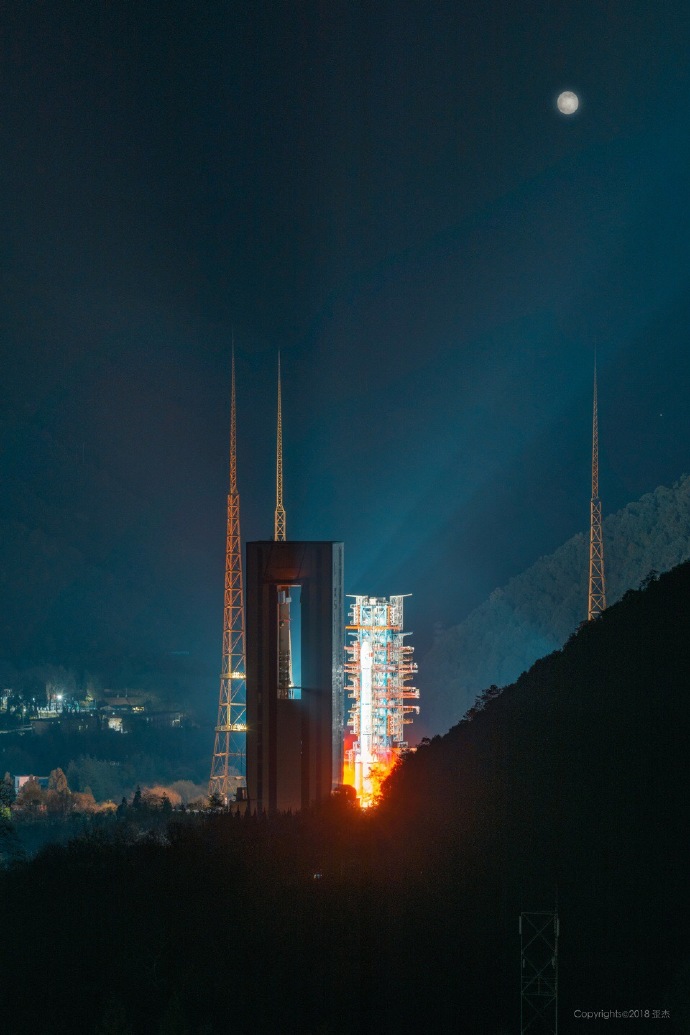

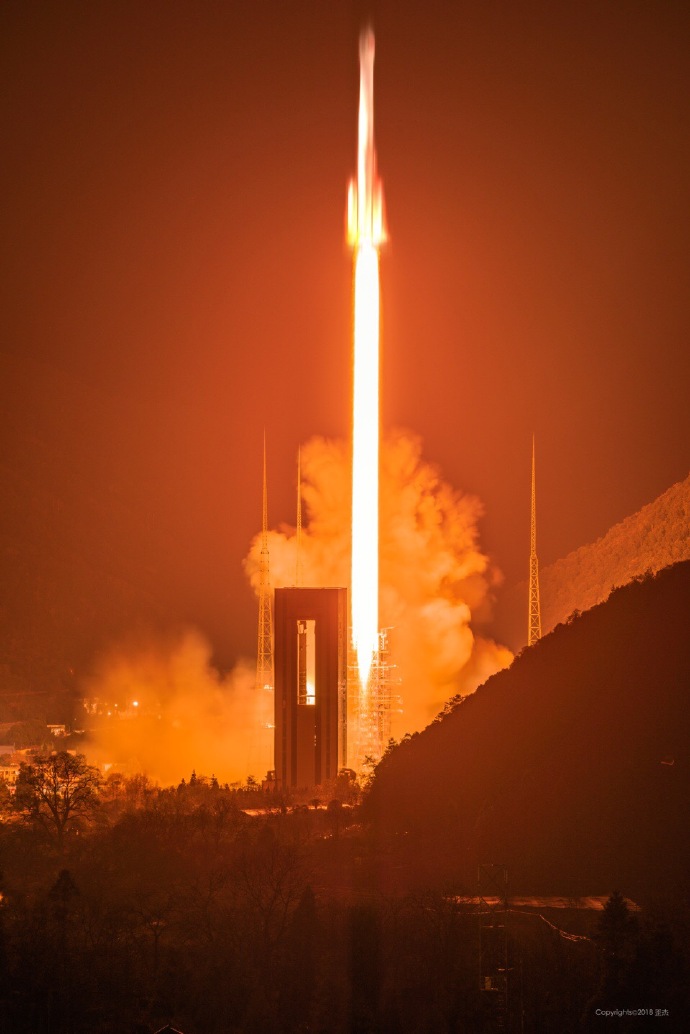

Load layout:
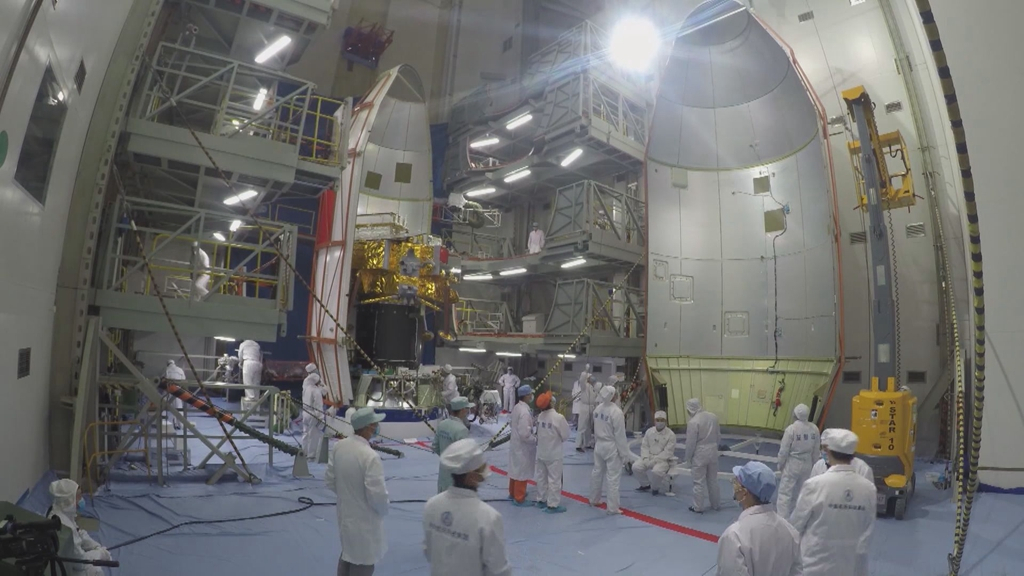

Thus, more than 60 years have passed since the first launch of the spacecraft - the Soviet Luna-1 station in 1959 - onto the moon.
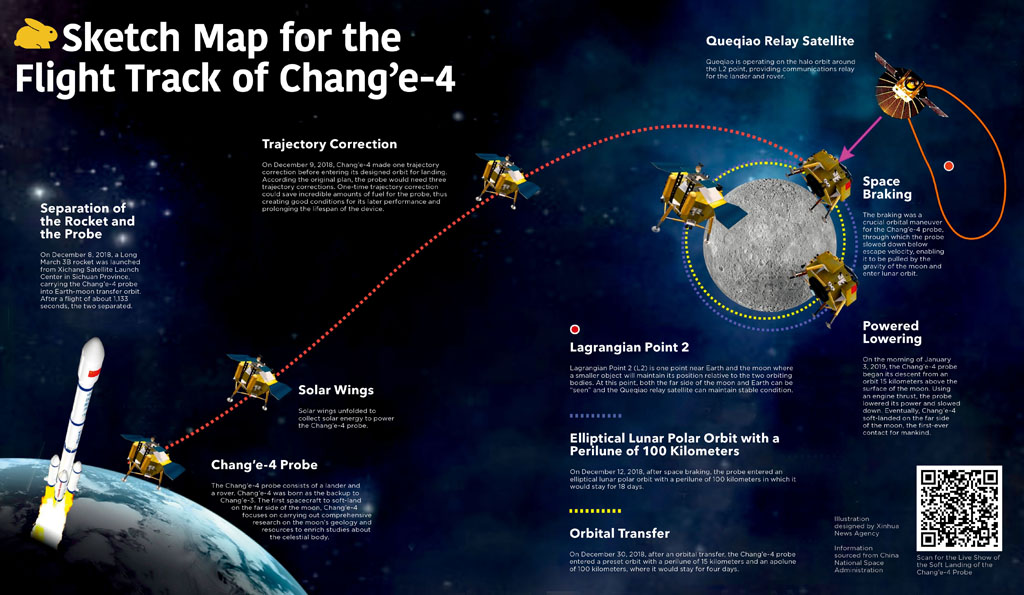
Libration points of the Earth-Moon system:

Here are some interesting facts about the cosmic lunar history and the Chang'e-4 mission from the lips of the Chang'e project participants and the creators of its modules, compiled from three conversations of China Pictorial journalists with scientists and engineers involved in the Chinese Moon Exploration Program.
Ye Peijian is the head of research at the Chinese Academy of Space Technology, a consultant to the chief designer and project manager of Chang'e.

Ye Peijian: “Having lived more than 70 years, I have seen many ups and downs. But now I am very excited and proud. People finally landed a spaceship on the far side of the moon. I was very lucky. Among the 7.5 billion people on Earth, the main team of the Chang'e-4 project consists of only a few hundred people. The opportunity to get into it is one in ten million. And we (my colleagues and I) received it. ”
Q: Were there any obstacles to the implementation of the three-year plan from 2001 to 2004, carried out in accordance with the feasibility studies of the Chinese lunar exploration program? What became the basis for the discussion and implementation of this program?Ye Peijian: It was a rather complicated process. Due to limited funding, we had to achieve scientific goals and progress in developing elements of a lunar space exploration program with a minimum number of launches. Thus, we planned to divide the project of unmanned exploration of the Moon into three stages - entering orbit, landing on the surface and returning to Earth. There were no obstacles to the development of this three-stage plan, but there were some disagreements as to how to begin the implementation of its first part.
Several options were presented and analyzed, but the research program proposed by experts from the Chinese Academy of Space Technology was ultimately chosen for two main reasons.
Firstly, we couldn’t borrow and use too many new technologies in our developments, which would be very risky, therefore we basically inherited the technologies of the two previous space programs and platforms - “Dongfanghong-3” (“Dongfang Hong-3”) and "China Earth Resource Satellite-2."
Secondly, China was late in exploring the moon, so we needed to use advanced methods to accelerate the implementation of the project and ensure its continuous continuation after the completion of each stage. In general, in this project we have achieved a fairly good balance between inherited technologies and innovations.
An important lesson that China has learned from manned spaceflight and moon exploration programs is the need to significantly think through each element of the project at the highest level. Throughout the three phases of our lunar exploration, we will adhere to the plan and maintain the cohesion of our team.
We all accepted this philosophy: while working on one stage, we consider how to use the technology used in the previous stage, as well as how to use the current experience in the next stage. This ensures that we continue to move forward, no matter how hard it is.
Question: After the Chang'e project was launched in 2004, it took your team three years to complete the creation of the first Chang'e-1 satellite, what were the most difficult tasks for these three years?Ye Peijian: When I assumed the role of Chang'e-1 chief designer, I took on a huge responsibility because I was also the chief designer and developer of another satellite - China Earth Resources Satellite-2, the first Chinese satellite to observe the Earth's surface. As you know, Chang'e-1 was the first Chinese satellite to explore the moon, and for the first time we faced many unprecedented technical problems, the solution of which was a very difficult and difficult test for us.
For example, how does a satellite approach the moon without being attracted to its surface by gravity? We could not experiment on Earth to answer this question.
And how should we ensure communication with a satellite in the Moon’s orbit at a distance of almost 400,000 kilometers from Earth?
To arrange positioning on the moon, ultraviolet radiation sensors are required, but at that time in China there was no such technology, so we had to start their development on our own.
A satellite in orbit of the Earth needs data on the coordinates of two bodies for its positioning, while a satellite of the Moon needs data on the coordinates of three bodies for its positioning, including the Earth, the Sun and the Moon, so its antenna must rotate. How could we realize this?
The temperature difference in the orbit of the moon can exceed 300 degrees Celsius, so how can satellite equipment survive such a temperature gradient when rotating in the orbit of the moon?
There were many more questions. As a result, we summarized seven key technical problems and solved them one after another.
Question: What was your most tense moment in the process of implementing the lunar research program?Ye Peijian: I continue to think that we all deserve this success after all our efforts. If we had not succeeded, we might have missed something. Our work on the Chang'e project was very meticulous.
We have worked through and considered hundreds of contingency plans that may arise for the Chang'e 4 mission. We took into account all the problematic issues that we could imagine, and we have special procedures for certain actions for those employees who are at the monitoring post and make decisions when technical problems arise. However, there is no absolute guarantee of success in any scientific experiment.
I witnessed the launch of each of the Chang'e mission spacecraft in person. As a key participant in the project, I always try to stay calm, so no one around is panicking. If I look worried, people can expect trouble from such a situation. At such a moment, I prefer the way of spending time, like the specialists in the flight control center, when they drink coffee and communicate quietly, and after all there is nothing left.
Question: How do you monitor the progress of the lunar exploration program and prevent potential risks?Ye Peijian: Despite the success of the Chang'e-1 mission, the start of the second phase of the program (launch of the Chang'e-2 mission) met with serious resistance. But should the Chang'e-1 satellite be China’s only successful attempt to reach the moon?
The development of the second satellite was already completed, and there was little reason not to launch it in order to gain more experience in the future. The Chang'e-2 satellite successfully reached the Lagrange point L2 of the Earth-Sun system, which is located at a distance of 1.5 million kilometers from the Earth, and also flew around the asteroid 4179 Tautatis and sent this photo:
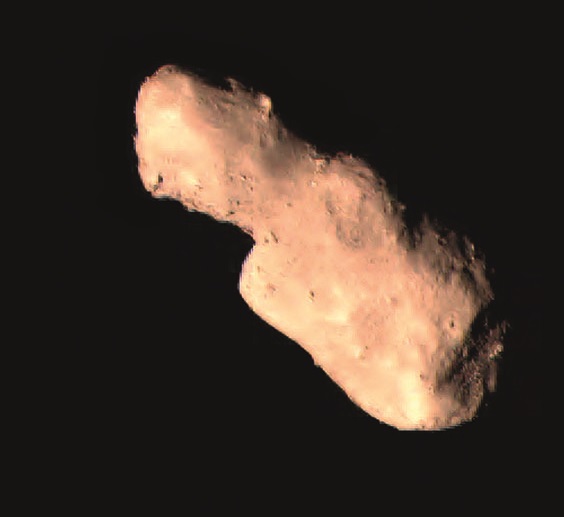
Before the fourth lunar mission, some objected to the idea Chang'e-4 landing on the far side of the moon. As the Chinese lunar exploration program continues, the flip side of the moon will always remain the key to innovation.
If a chance arises, why miss it and spend more time and money in the future to do the same?
In the process of implementing the Chang'e-4 mission, we encountered many problems that arose due to technical limitations that appear on the far side of the moon. The most serious problem was the organization of communication. Therefore, we launched a relay satellite in advance.
The surface of the back of the moon is replete with stones and craters, so for landing it was necessary to use an array of special sensors to analyze the terrain and choose a safe place for landing, which we also successfully completed.
Question: One of the goals of the Chang'e-4 mission is international cooperation in the field of scientific research, which was ultimately provided by four international partners. What is your opinion on such cooperation?Ye Peijian: The moon is still far away and only a limited number of landings have been made on it, and scientists around the world take every opportunity to conduct research there.
International cooperation fosters human development by demonstrating China's openness to research.
Unfortunately, some international moon research projects exclude the participation of China, but we do not seek to exclude anyone. All countries can participate in the construction of our lunar space station and in lunar exploration.
American scientists have proposed increasing the operating time of the Chinese lunar relay satellite "Tseyuqiao" to five years. They hope to use this satellite, and we also welcome this.
Question: What are the goals of exploring the moon?Ye Peijian: Was the Moon a Part of the Earth? Or did it arise simultaneously with the Earth? Hints to answer this question have not yet been found.
Moon exploration can improve our understanding of the formation of the universe. The moon is also rich in resources. For example, regolithic helium-3 deposits on the moon can be used to generate energy.
According to calculations, the stock of helium-3 on the moon could last for humanity for 10,000 years. The difficulty is how to use its reserves on the Moon or transport it to Earth. At the moment, this may seem technically difficult, but what about a century or two? It is not available now, but it will not necessarily be available in the future.
Question: Tell us about the dynamics of China's deep space exploration programs compared to other countries.Ye Peijian: Moon exploration restored the popularity of space programs in the 21st century. But we do not expect China to achieve remarkable new results in a short time. Our efforts have paid off, but in general we are still lagging behind other countries in this area.
Our goal is to deliver samples from the Moon back to Earth this year or early next.
We are also developing a project to send our taikonauts to the moon, plan to visit the South and North lunar poles. In the foreseeable future, we will lead in the exploration of the moon.
According to our plan, the Mars-1 station will be launched in 2020. Its goal will be not only access to the orbit of Mars, but also the landing of a 240-kilogram rover. In September 2018, Chinese engineers carried out successful statospheric tests of the parachute, which will be used to damp the landing speed of the Martian descent vehicle.
If the plan succeeds, then China will be one step ahead in the study of Mars. We also plan to explore asteroids and reach Jupiter on the 100th anniversary of the founding of the People's Republic of China. Only after these steps are completed, will China take a leading position in deep space exploration.
Temperature tests of the Chang'e-4 descent vehicle:
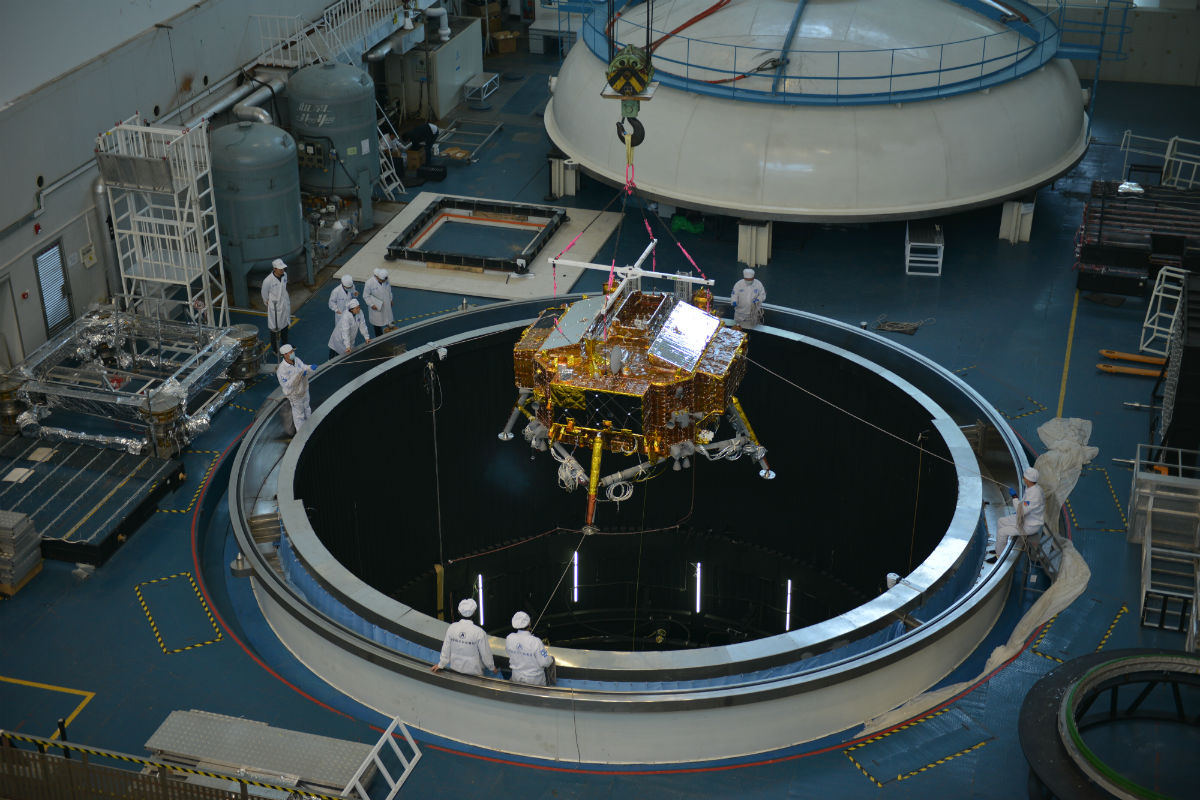
The most important job is to install the “national flag” element:
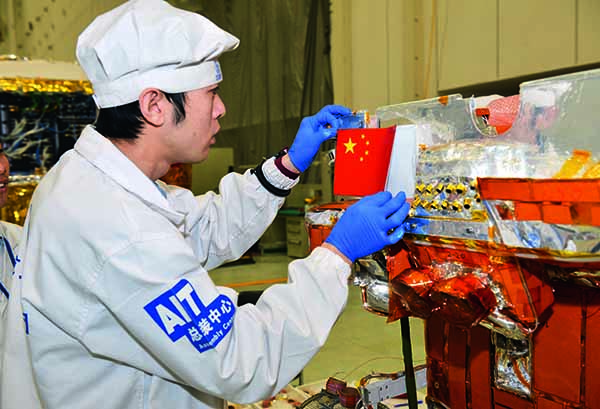
Zhang He- Executive Director of the Chang'e-4 project: This part of the picture and icon on the monitors is
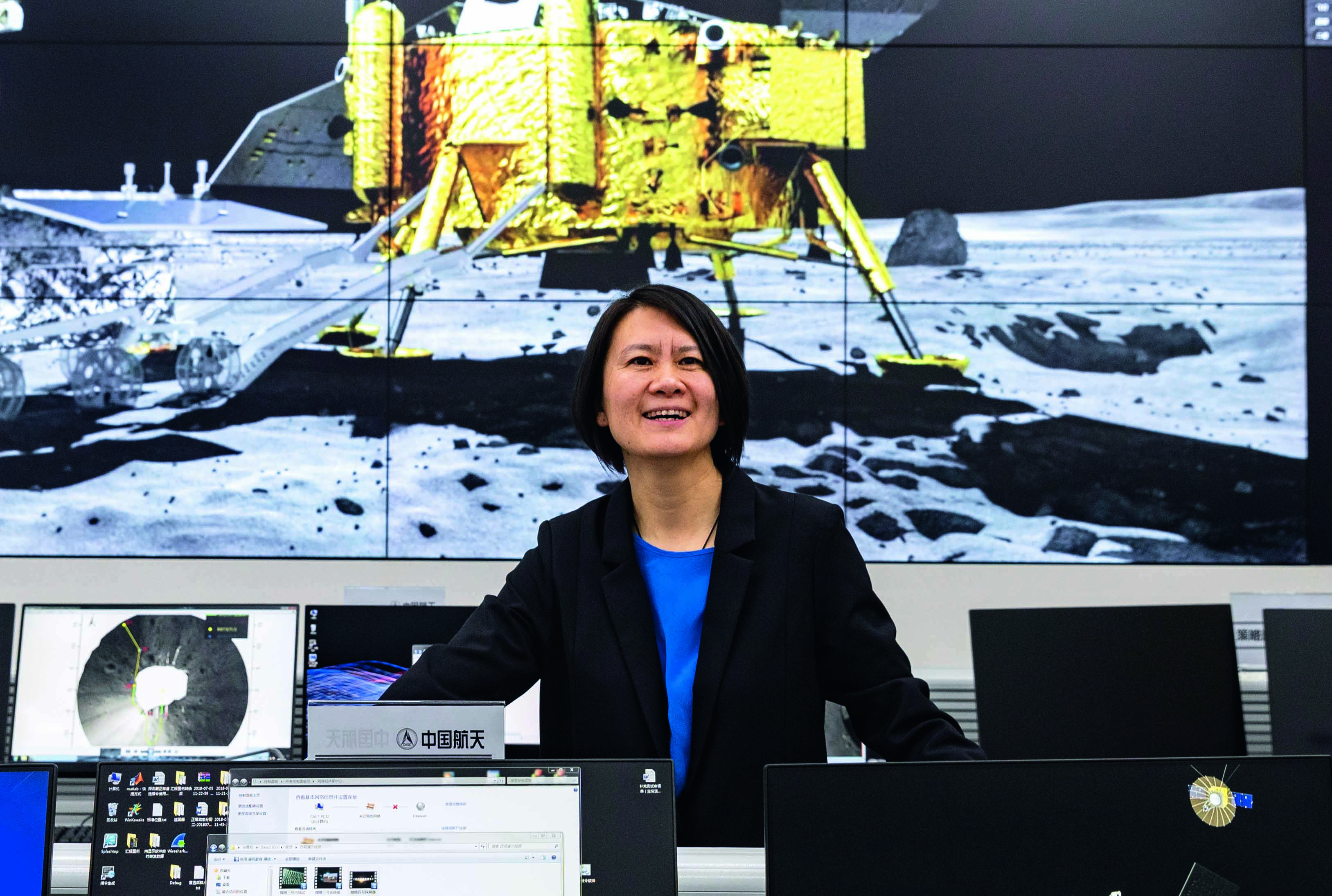
interesting : Zhang He: “Exploring the back of the moon has always been a dream for scientists around the world. The pictures sent by the Chang'e-4 lander and the Yutu-2 rover represent a completely different picture of the back of the moon than we imagined. In addition, analysis of the results of lunar studies of the visible and reverse sides of the Moon can lead to new scientific discoveries that will be of great importance to scientists and engineers around the world.

Question: From take-off to landing, when were you most nervous? What do you think was the most important success factor for the Chang'e 4 mission?Zhang He: Three points made my heart freeze. The first point was the launch of the rocket, the launch of the device in the correct orbit, and the deployment of solar panels to provide energy.
The second moment was the phase of cosmic drag. If Chang-4 had not slowed down as it approached the moon, then it would have flown past it and carried off into space. Thus, his speed and position had to be precisely controlled. Otherwise, he would not even be able to rotate around the moon in the necessary orbit.
The last but most nervous moment was the slow descent process and the landing procedure. In contrast to the control of the Chang'e-3 modules, the telemetry from the Chang'e-4 comes from the satellite relay Tseyutsiao, which leads to a delay in receiving data in two to three minutes. This eliminates any possibility of quickly changing the direction of movement from the Earth. Thus, the entire landing process was automated and it was not possible to remotely control this procedure.
Each landing support of the Chang'e-4 descent module has a surface touch sensor. When we saw that all four sensors worked out the touch, and also received the first image from the camera of the descent module, we realized that the Chang'e-4, finally, landed on the moon. The next task was the automatic opening of the solar panels. After its completion, we realized that we had avoided the most dangerous problems at this stage of the mission, and felt relieved.
Very pitted in comparison with the visible side, the reverse side of the moon is full of craters. Therefore, unlike Chang'e-3, we adjusted the landing procedure and made many changes to the Chang'e-4 landing machine software for automatic control. The Chang'e-3 descent module descended in an arc upon landing on the moon. The Chang'e-4 landing module first moved horizontally, slowing down, and then reaching a height of six kilometers above the planned landing site, descended almost vertically to the landing site to avoid possible obstacles.
Operators on Earth could track Chang'e-3's landing with a very short time delay. Communication with the Chang'e-4 landing module required much more time, so we could not quickly respond to possible failures during the landing in real time. Thus, the Chang'e-4 landing module worked in automatic mode, controlling engine modes and receiving data from on-board sensors.
Question: Tell us about possible problems and obstacles during scientific research that the Chang'e-4 descent vehicle and the Yutu-2 rover on the far side of the moon may encounter. What are the biggest discoveries they can make?Zhang He: Since the evolution of the opposite and visible sides of the moon is very different, we hope that the Chang'e-4 project will help to make new discoveries by analyzing the surface material (soil) on the back of the moon, which is carried out using an infrared spectrometer mounted on the rover Yutu-2.
Also, the Yutu-2 rover is equipped with an electromagnetic radar. This radar sends electromagnetic pulses that pass through the lunar soil and are reflected from formations under the surface of the moon, allowing you to collect information about the layered structure of the lunar crust. We hope that the Yutu-2 rover will move on, scanning as much space as possible.
The most difficult part of the project at this stage is the conduct of low-frequency radio astronomy observations of the Universe, the Sun and other celestial bodies. These observations are complicated by the fact that the Chang'e-4 modules also emit a lot of low-frequency electromagnetic signals.
According to the data that we have already received, much work remains to be done to remove interference from them and to isolate low-frequency radio signals from the Universe, especially from the Sun.
Question: What is the biggest difference between the Chang'e-3 and Chang'e-4 project modules?Zhang He: The two landers, Chang'e-3 and Chang'e-4, look the same, but they are completely different in filling.
Firstly, since the Chang'e-4 guided landing navigation strategy is different from the Chang'e-3 landing procedure strategy, all navigation sensors, rangefinder sensors and speed sensors are specially modified for use when landing on the far side of the moon.
The second difference is the collection of data on surface and soil temperatures during a moonlit night, which could not be implemented in the Chang'e-3 project.
The Chang'e-4 project uses modern technological advances to solve the problem of continuous power supply of a temperature measuring device during a moonlit night, when the main components of the modules are in "sleep mode".
The Chang'e-4 descent module is capable of taking soil temperature measurements underneath at several points, as well as receiving other data.
Question: What is your most vivid memory of working on the Chang'e-4 project?Zhang He: Participation in the lunar research program gave me more courage to solve complex problems, I became more competent in many technical issues.
When I just started working in the Chang'e project, I once participated in testing the engine. At some instant, the sound of creaking engine elements became very loud, this situation unsettled me, and I began to get very nervous. My colleagues reassured me, saying: "It will take some time, and you will get used to it." Time passed, and now I'm used to a lot.
Another time during a mechanical experiment, I again came across an amplifying sound, as if the entire satellite started resonating in a different frequency band. When this huge noise surrounded me, I stopped getting nervous and worried that something had gone wrong with the project.
It was a hard exercise for my mental stamina. By doing more of these exercises, I tend to believe that any problem can be solved no matter how difficult it is.


I was obsessed with love for the stars since childhood and took many photos of celestial bodies. I dream to develop further and see more extraterrestrial celestial bodies. Therefore, I was very lucky that my work is directly related to comic research and I am a member of the Chinese team of moon explorers.
Jia Yang , deputy chief designer of the Chang'e-4 lander, and designer of the Yutu Chinese lunar rover
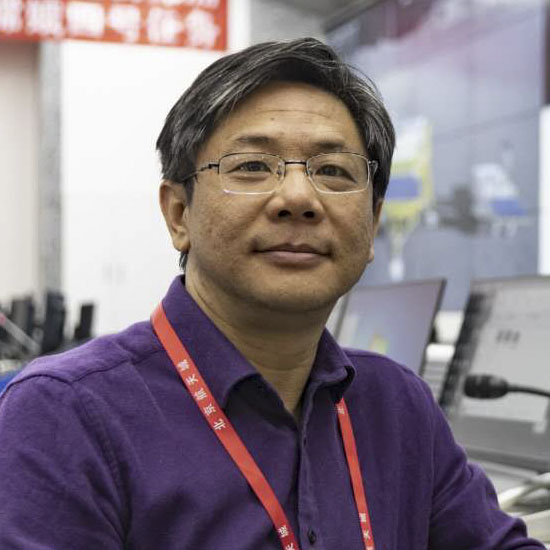
Question: It is true that the Chang'e-4 mission was originally planned as an understudy of the Chang'e-3 mission. Why, then, did Chang'e-4 be sent on a dangerous solitary mission to the far side of the moon, and not be "combined" with its predecessor according to an already worked out scenario?Jia Yang: For the Chang'e-4 mission, several possible routes were planned, including landing near the Chang'e-3 landing site. But in the end we still decided to land the Chang'e-4 on the far side of the moon. The reason this decision was made was simple: although humanity has explored the moon many times, an automatic landing on the far side of the moon would be an unprecedented feat.
Question: If there is no evidence of aliens or alien spaceships on the far side of the moon, what then is there that attracts scientists so much?Jia Yang: The moon is an ancient celestial body. She was active three billion years ago, but is calm there now. The landing on the far side of the moon gives us clues about its evolution, which greatly contributes to the study of the early history of the moon and the earth.
Question: A moonlit night lasts two weeks, how during this period the Chang'e-4 descent vehicle and the Yutu-2 lunar rover operate in complete darkness?Jia Yang: Without solar energy, on a cold moonlit night, the lander and the rover lose energy and go into sleep mode. During this cold season, the special internal elements of the modules radiate heat, which helps them survive the night.
Question: Why was the Yutu-2 rover designed as a six-wheeled all-terrain vehicle, and caterpillar tracks were not used in it? If the Yutu-2 rover topples over, can it restore its position?Jia Yang: The wheel elements of the Yut-2 rover are indeed its complex structural feature, which had to be further developed at the design stage. We refused to use tracks because they turned out to be less maintainable and vulnerable in tests.
For example, if a small stone gets inside the track mechanism, the rover may become stuck and lose track. In contrast to the wheeled implementation, which is more reliable and has an increased resource, it can also safely move stones up to 20 centimeters high.
However, if the Yutu-2 rover rolls over, it will not be able to return to its working position again. The solar panels on the sides of the lunar rover are very fragile, they can crack or become dusty after falling, which will render them unusable.
Thus, we focused on keeping the position of the Yutu-2 rover as stable as possible and preventing it from falling when moving along the surface.
Question: Is it possible to transmit live from the surface of the far side of the moon with the help of the repeater of the Tseyuqiao satellite?Jia Yang: Theoretically, this is possible, but the current communication channels cannot meet the requirements for real-time video streaming.
Question: How long will the Yutu-2 rover work on the moon? How far can he drive?Jia Yang: Its estimated life expectancy is about three months, range of up to 10 km. He has already traveled more than his predecessor rover Yut.
It is hard to say how long it will take in two months to travel, but now it travels no more than 50-80 meters in a lunar day, it makes no sense to drive it on the surface, since the lunar surface is not a track, but a place for scientific research. But we hope that his resource will be enough for a few more months.
Question: Traces of the Yutu-2 rover will remain on the moon forever?Jia Yang: It depends on what is meant by the word "forever." For example, marks on the surface of the moon from its wheels will remain for at least hundreds of thousands of years.
Question: What data can the Yutu-2 rover send back to Earth from the far side of the moon?Jia Yang: the Yutu-2 rover is equipped with scientific instruments for geophysical studies of the lunar surface, including stratification of the soil, soil temperature, analysis of mineral elements and so on.
Q: How far apart are the two Chinese lunar rovers? Is it possible for them to meet? Will new Yut rovers be sent to the moon?Jia Yang: Two lunar rovers “Yutu” and “Yutu-2” are respectively on the visible and back sides of the moon, at a very large distance from each other. They are not destined to meet in any way. I really hope that in the future there will be more Yut rovers on the Moon and other celestial bodies.
Assembling the Yutu-2 rover elements at the Chinese Academy of Space Technology:

Yutu-2

rover tested at the Chinese Academy of Space Technologies: Workers inspecting the Yutu-2 rover elements in the assembly shop:

Photo of the lunar surface near the rover:

Presentation of the rover in Beijing, August 15, 2018:




